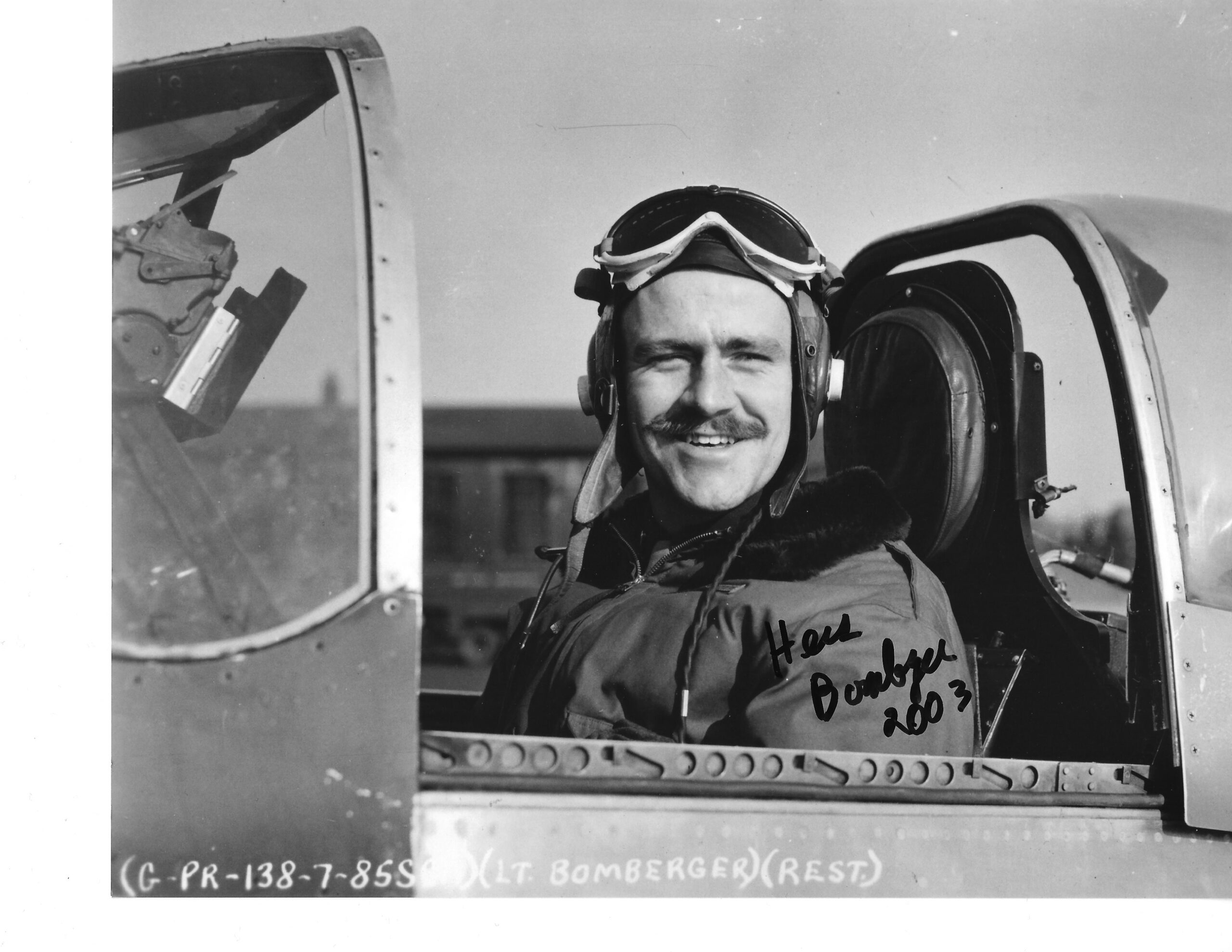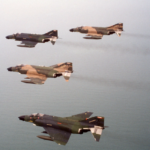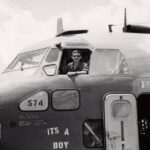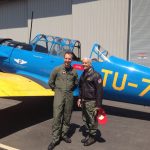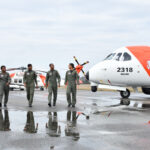Charles Lindbergh influenced you, at least some, to be a flyer. What are your thoughts about him?
I was five when he crossed the Atlantic and I know my mother thought he was a big deal. I did make a lot of model airplanes as a kid. I saw Lindbergh at a party just after the war, but didn’t talk with him. Lindbergh was a strange guy, in some ways. While he was waiting to take off for his flight across the Atlantic, his mother came down to visit.The newspaper guys wanted his mother to stand by him for a picture but he wouldn’t do it. Of course, they doctored a picture of them to print. During the war, we heard that Lindbergh had done some training of P-38 pilots to improve fuel management and give them better range. There were probably some other things he did during the war, but we’re not supposed to know about that because he was a civilian, so I’ve heard. Anyway, after the war I was assigned to Eglin AFB in Florida and went to put my stuff in the locker they had assigned me. Lindbergh’s name was on it, so he was doing something down there to help the cause.
I know your Dad took you to the Cleveland National Air Races in 1937. Isn’t that where you first saw a B-17?
Yes, and that’s where I met Lt. Curtis LeMay, as a 2nd Lieutenant, before he was really known. I was just a high school kid, I think a Junior.I saw him standing by one of the 11 or 12 B-17s there at the show and asked him “Do you fly these?” He just said “Naw, not enough hours.” He said he was just flying co-pilot at the time. Well, I didn’t have a concept at the time about what hours really meant and just gabbed with him a little. I never realized who he was until years later when I looked at a newspaper article I had kept and saw his name. The next time I met him he was a four-star general and asked me what I was doing at Wright Field. Who knows what I said.
Speaking of Wright Field, you were assigned there after the war, right? What was it you told me about Orville Wright and this time?
Yes, I was there and wanted to get some of the advanced training they offered. Housing was pretty tight at the time and I found a room with a family. The grandmother lived with them and she had been playmates with Wilbur and Orville Wright. She kind of hinted that she would sometime ask Orville over for dinner some time but never did.
You flew Mustangs in a lot of poor weather over Europe, especially in the particularly cold winter of 1944-45. Just how dangerous was that?
In early 1945 we were coming back from a mission to our base in Martlesham Heath. Being winter and being Europe, the weather can quickly become dicey and it did that day. We were diverted to a base in France, a bomber base, so we headed in. I don’t recall exactly where it was. I was in the second flight and our Squadron Commander Don Strait was in the first who led the way. Don went in first and I could see him land right down the middle of the runway, which had been cleared of snow that had been piled up to the sides. I didn’t hear anything on the radio from Don, so we assumed that all was good to go. Now this was when we had some really green guys in the group and one of these guys was in Don’s flight. One of them went second, just after Don, but didn’t stay right down the middle of the runway. Being a bomber base, the wing clearance from the ground is significantly different from that of a P-51, and I guess they had just piled the snow as best as they could so the bombers could land. Well, this guy just got too close to the edge, his wing caught one of the piles, and over he went, flipped over at the side of the runway. The runway stayed clear and when my time came, yes, I stayed in the middle as did everyone else and all was OK. As I taxied by him, I could see him upside down, yelling, and there were French farmers nearby leaning on their hoes, or some sorts of implements. Fortunately, the guy survived pretty unscathed. I think he may have used his .45 pistol to shoot out the canopy and later I heard that he also lost a borrowed watch. Not a good day for him, but these are the sorts of things that happen in war.
George Preddy was pretty well known by fighter pilots in the 8th Air Force by being the leading P-51 ace in the European Theater. How did you get to meet him?
Preddy was apparently making the rounds to a bunch of fighter bases to give pep talks and pass on what he had learned. He came over to Martlesham Heath and of course, we were all ears when he talked about his experiences, tactics and so forth. He cranked up and took off to go home and immediately after takeoff did a wheels-down roll. Wow, we thought this guy really knew his stuff about the P-51 but I don’t think any of us thought we’d ever do that. Later I learned from someone in his group on the ship I was coming home on that he had talked about this to them. When he went to drop his gear to land, he saw that it was already down. Turns out he had just forgotten to retract his gear!
Are there any particularly sad moments you recall during your wartime service?
Yes, saw a bomber, a B-24, take a direct hit and explode into pieces. Amidst all the pieces falling, I saw two chutes streaming down, both with guys. As I watched, I could see that the chutes were on fire and smoking. They went faster and faster as the fire spread to the risers and I just had to look away. Those guys never had a chance. Somewhere in Germany I shot up a train but aimed for the locomotive. It blew up and maybe the guys up there made it, but I don’t know.
You flew both P-47s and P-51s. What do you remember about the P-47?
The P-47 was a lot warmer than the P-51. Its exhausts went by the cockpit to the supercharger in the rear. I liked that it had eight guns instead of six. It was kind of sluggish in some ways but a great plane. Got the order to go on a mission to the Ruhr Valley when we had P-47s and all I could think of was the flak we would get. We were at 20,000 feet going back and forth over the undercast and couldn’t see the ground. I was thinking, how are we ever going to see the Ruhr Valley? We stayed in combat formation and then boom, boom, boom. I heard a click, smelled something burning, but the instruments all checked out OK. Those guys on the ground had figured us out pretty well. Forgot about the clicking and headed home. Came in to land, put down the flaps but instead of going down, they went up. I was going down faster than going forward, it seemed. Luckily I landed the plane at another airfield and found out that the flak had clipped a hydraulic line.
Did anything happen about the P-51 that surprised you?
When we first got our 51s, there were some accidents where a wing sheared off and killed the guy. It was a mystery until one fellow made it back to base with some damage from a dive. Seems that the landing gear would drop just a little and air would catch in the wheel well and rip things apart. The wheel cover was held tightly by hydraulic pressure and if that eased some, well, it would drop a little. They ended up fixing this with a latch that would lock when the wheels retracted. It wasn’t until much later when I was reading through my logbook and saw where I had lost a panel out of the canopy of a P-51B or C I was flying. I wrote that I was doing about 400 mph. I’d forgotten all about it.
Didn’t you see some Me 262s right at the end of the war?
Yes, our new squadron leader on my last combat mission took us way into Germany, really I think just to get some time. This was after Don Strait had left for the States. This new guy was really “hot spit” and I guess just wanted to get in some flight hours. Anyway, I saw the 262s circling a city down below and then two of them just came up at us. I was kind of startled but advanced the throttle and went after the one which went high as the other went low. Didn’t get any shots off but when thinking back, I should have just moved the nose around a little and sprayed out some rounds.
What else is interesting about your home town of Jeanette, Pennsylvania, before or during the war?
Vaughn Monroe, before he was the famous band leader, would come over and teach my brother trumpet. A really nice guy, he was. My mother was an excellent pianist and encouraged him to pursue his ambitions, for what that’s worth. Bill Shomo, a couple of years ahead of me in school, was a friend of mine and a big deal. Got in a tangle and became an ace in a day with seven kills. His group mostly flew Aircobras but those didn’t have cameras so they got newspaper type cameras to shoot recon. Not the best thing. Then he got an F5 Mustang, the recon version, and his flight got into a Japanese formation of 11 planes,a bomber and 10 fighters, I believe on his first or second mission in the F5s. Quite a day for him. Saw him later at an airshow in Pittsburgh in the 1980s.
About the pilot…
Born in 1921 and raised in Jeannette, PA, A. Hess Bomberger II, Lt. Col., USAF, Retired, learned to fly in the Civilian Pilot Training Program at the Latrobe, PA airport (now Arnold Palmer Regional Airport) the summer of 1941. He flew 65 hp Piper J-3 Cubs there and a Waco RNF and Meyers OTW at the Lancaster, PA airport before being appointed an Army Aviation Cadet in June, 1942.
He flew 66 missions for 284 combat hours in P-47s and P-51s with the 361st Sq of the 356th Fighter Group, 67th FW, 1st Air Div, 8th AF from September, 1944 to May, 1945. He served with Colonel Donald Strait (later Maj. General), who was the leading ace of the 356th Fighter Group. Based at Martlesham Heath Aerodrome near Ipswich, Suffolk, England, he rose to Flight Commander with the rank of Captain, and earned the Distinguished Flying Cross, seven Air Medals and six other military awards.
Other operational tours were in F-86Fs in Korea and F-86Hs stateside. The rest of his military career was in research and development at Wright and Eglin Fields. He retired in 1963 as Chief, Configuration Management in the T-38/F-5 Program Office at Wright Field.
After retiring from the Air Force and civilian positions in the federal government, he resumed flying the P-51 after purchasing a P-51D Mustang in 1979, painting it in his squadron scheme when in Europe. Heritage Aircraft, Inc. was then formed to showcase the operation of the Mustang at airshows throughout the east coast, which for a number of years included another Mustang, “Jumpin Jacques.” Bomberger had over 1,000 hours in the P-51, plus 3,500 hours in some 40 others from the Piper Cub to the supersonic T-38. Most of his P-51 hours were gained by flying his P-51 Mustang which he named Vergeltungswaffe after his wartime mount, and which was bought from racecar driver Johnny Rutherford in 1979. Vergeltungswaffe was seen with Hess at the controls to the delight of spectators at scores of airshows on the east coast for next 19 years until he retired from flying. He lived in Gainesville, Georgia until his death in 2023 at the age of 101.
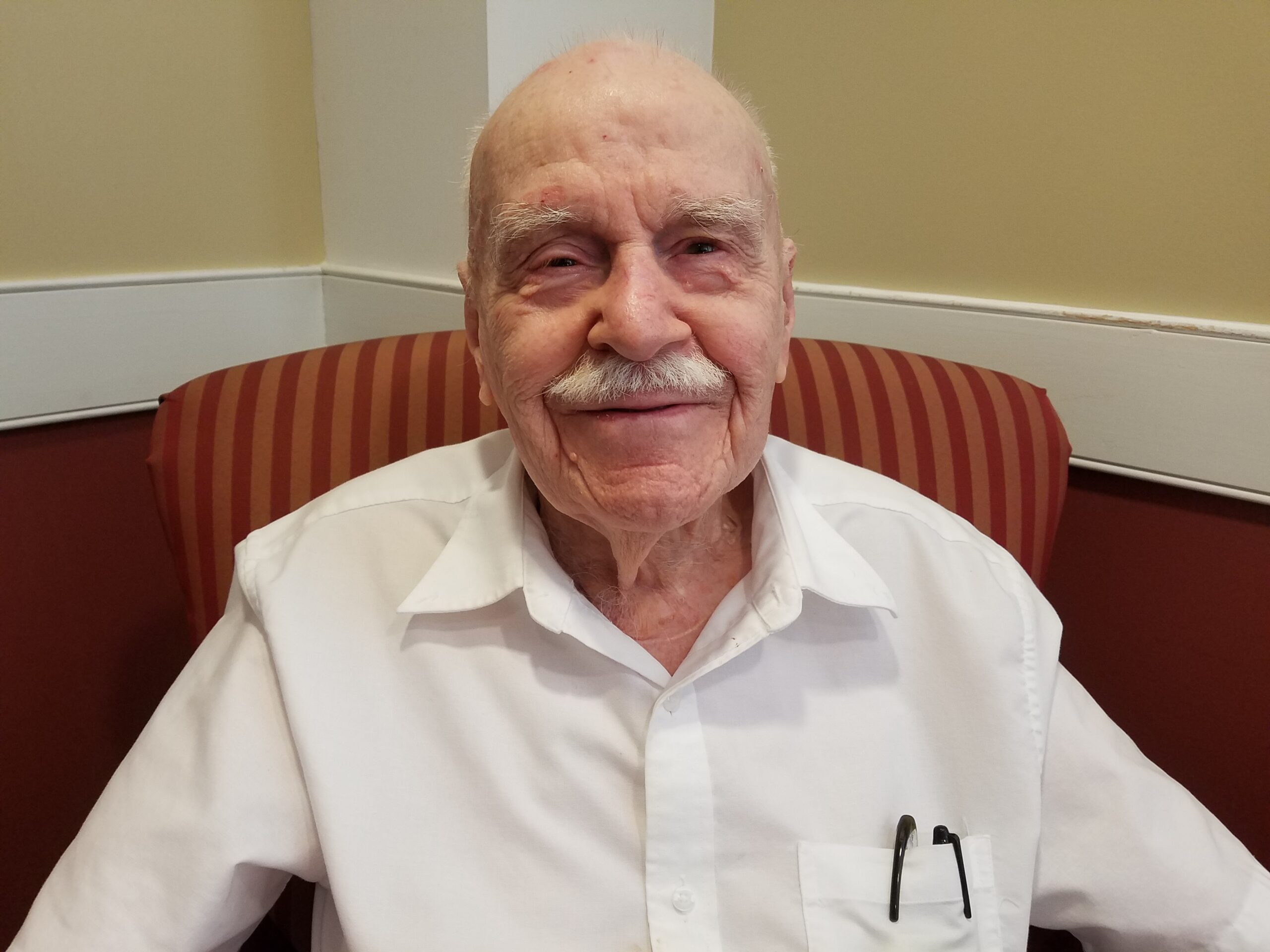
About his P-51 Vergeltungswaffe he flew from 1979-1998 (now flying as “The Little Witch” out of Stallion 51 in Kissimmee, FL)…
One of the last P-51D’s made, it saw no combat. It was delivered to Bartow Army Airfield, Florida, 6 June 1945, and to Kelly, Texas, a year later. In November of 1950 it was transferred to the RCAF Auxiliary (reserve) at London, Ontario, after two months of contractor maintenance at Burbank, CA. In 1953 it was stored at Ft. Macleod, Alberta. Among some twenty sold by Crown Assets Disposal Corp in 1960, it was apparently not claimed, and in Jan 1962 was sold for $2,500 at a Calgary sheriff’s sale.
Bomberger’s Heritage Aircraft was the ninth civilian owner, a company formed with fellow pilot Jimmie Hunt. Vergeltungswaffe was equipped with an operating K-14 computing gunsight and was thought to be the only Mustang flying in the world at that time to make this claim. The paint scheme during Bomberger’s ownership duplicated, to the rivet, that of the P-51D-15NA flown in combat by him. Copied from black and white photos, true colors were taken from his combat helmet which was painted with the 1944 aircraft paint.
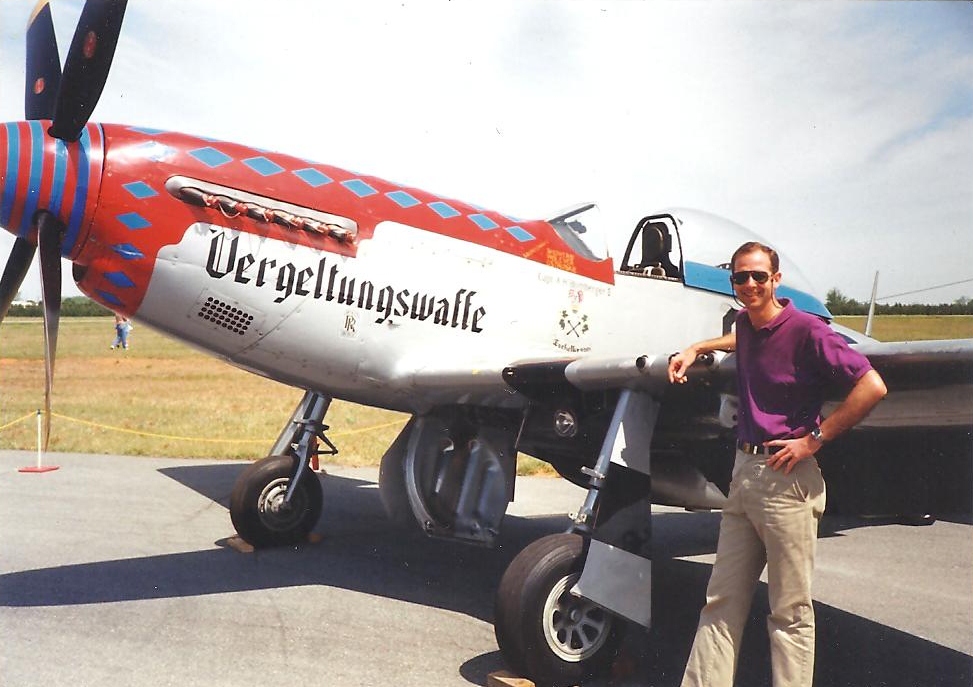
“Vergeltungswaffe” is the German word for “retaliation weapon.” It is what the “V” stood for in the V-1 flying bomb and V-2 rocket. The coat-of-arms under his name is that of the barony in Baden, Germany from which his paternal ancestor came eight generations ago in 1722.
Vergeltungswaffe’s ownership passed into the hands of Bob Jepsen but is now most recently in the hands of Ariel Luedi. Shortly after Bomberger sold it in 1998, it received extensive modification as a “Cavalier” two-seat version and now flies as The Little Witch out of Luedi’s base of operations at Stallion 51 Corp. in Kissimmee, Florida.







